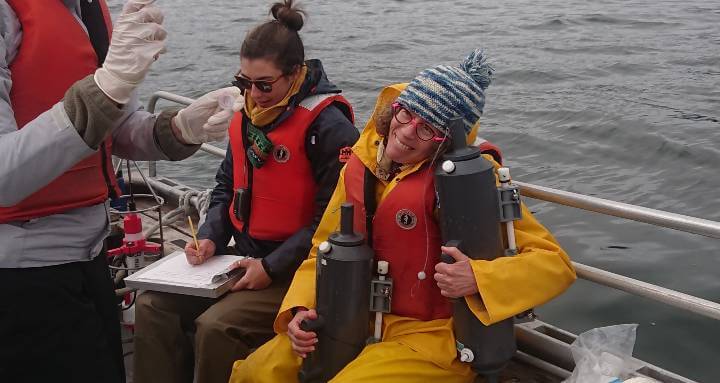Hamme wins teaching award for innovative and engaging courses

December 13, 2023 | by Nicole Crozier, Science Communications Officer
If you see someone with a GoPro and an aquarium at the front of the classroom, there’s a good chance it is Earth & Ocean Sciences professor Roberta Hamme. Using the aquarium and coloured dye, she teaches her students about the movements of ocean currents; the GoPro helps to ensure all students can see her demonstration up close, even from the back of the 300 person lecture hall. This is just one of the many engaging teaching techniques Hamme has infused into her classes, and just one of the reasons she has been named one of two recipients of the 2022-23 Faculty of Science Award for Teaching Excellence.
“Roberta is an exceptionally gifted and effective teacher who is dedicated to providing students with high-quality experiential learning opportunities,” says Peter Loock, dean of science. “The Faculty of Science Award for Teaching Excellence recognizes and rewards excellence in teaching in our Faculty, and Roberta’s commitment to experiential learning, innovative course design and student success make her an extremely deserving recipient.”
Overhauling a first-year course
Hamme has been a member of the School of Earth & Ocean Sciences (SEOS) for the past 17 years and has built an impressive record of new courses, redesigned courses and new programs in that time. In 2019, she took over as the lead instructor for Oceans and Atmosphere (EOS 110), a foundational course for earth and ocean science majors. She immediately undertook a major redesign of the course, reorganizing the course material to better integrate lecture and lab material. While the two components had previously been quite disparate, the lab work now allows students to apply the concepts covered in lectures. Since 2019, she has also worked with senior lab instructor Ed Wiebe to design two new labs that allow students to apply important conceptual ideas. Students now learn about marine pollution, measuring the content of microplastics in beach sand, and explore how plankton responds to different seasonal conditions using a computer simulation with lots of what-if games.
Hamme has also redesigned individual lectures, bringing active engagement techniques to the course. She often combines lecturing with real-time calculations on the overhead or whiteboard, walks students through thought experiments or asks students to discuss questions with their neighbours. Students are then asked to log their answers using interactive software, which helps her determine how well they understand a concept. Hamme is also known for incorporating live demonstrations into her lectures, including a bringing a large aquarium to class and using dye to illustrate thermohaline circulation in the ocean. Collectively, Hamme’s changes have resulted in a doubling of lecture attendance.
Incorporating project-based learning
Hamme believes in allowing students to take ownership of their own educational experience, and nowhere is this more evident then in Chemical Oceanography (EOS 312), a course she created from scratch. EOS 312 uses a flipped classroom model, where students are expected to read the textbook in advance of class. Class time is then used to discuss concepts in small groups, and as a larger class, with Hamme concentrating on the concepts and problems that students found most challenging. The lab portion of this course involves a term-long project that also allows students to take ownership of their learning. Students create their own field sampling program, collaborating to determine what type and where samples will be collected, before heading into the field to collect the samples themselves. The project culminates in a poster session where each student presents a project based on some aspect of the data collected during the field work.
“EOS 312 is an extraordinary experience for students, giving them ownership of their work and engaging them in ways I haven’t observed before,” says Karina Giesbrecht, a former SEOS senior lab instructor. “By challenging students to think beyond the classroom and embrace the mindset of a scientist, she equips them with the necessary skills to excel in their future endeavours.”
Beyond the classroom
Hamme’s impact on the education of students in the School of Earth & Sciences extends beyond the courses she teaches. She is an active contributor to program development in the department and was a key contributor to the revised ocean science minor program, as well as the department’s combined programs with chemistry and physics. In addition to her contributions to EOS 110 and 312, Hamme has recently begun to teach Biological Oceanography (BIOL/EOS 311) and the Oceanographic Field School (EOS 401) at Bamfield, and is bringing her focus on course flow, engagement and experiential learning to those courses as well. Her impact also extends beyond SEOS, and even UVic, as she has recently co-authored a new textbook, Chemical Oceanography: Element Fluxes in the Sea, which provides a comprehensive, up-to-date reference where concepts build progressively and students have access to practice problems.
“Roberta has been a force in shaping how SEOS offers undergraduate and graduate programming,” says Jay Cullen, director of the School of Earth and Ocean Sciences. “Through the investment of large amounts of time, intellect, passion and expertise, Roberta has built an impressive record of teaching excellence at UVic. Though her courses are often considered to be challenging, they are often cited by her students as a highlight of their time at UVic. We’re lucky to have her in the department.”
